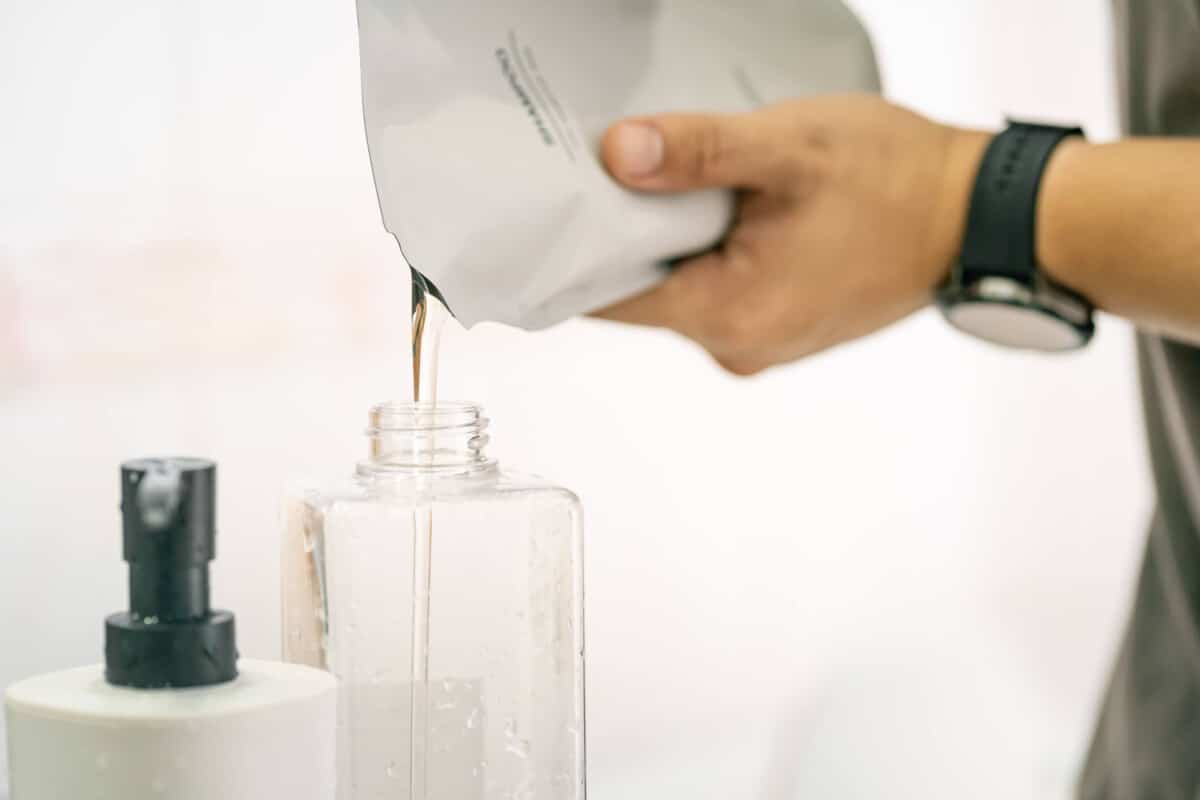Eco-Friendly Bathroom Ideas: Simple Steps to Create a Sustainable Space

Terms like “Climate Crisis” have become part of our daily vocabulary, and it’s clear that many of us are eager to make more sustainable choices.
After all, 2024 was Britain’s fourth hottest year on record, and plastic has infiltrated everything from our oceans to our food. With all this in mind, it’s no surprise that we all want to help make a positive impact on our planet.
If you’re looking for ways to make your home more eco-friendly, the bathroom is a great place to start. Whilst sustainable bathroom designs might seem daunting, costly, or even impractical, they don’t have to be.
In this article, we’ve simplified the process with our top tips on how you can create an eco-friendly bathroom that makes a positive impact on the environment.
1. Invest in water-saving devices
2. Consider eco-friendly paint and materials
3. Choose natural, energy-efficient options
4. Install energy-saving fittings
5. Choose sustainable single-use products
6. Buy refillable containers
7. Use eco-friendly cleaning products
Invest in water-saving devices
Saving on water is the obvious place to start if you want to create a sustainable bathroom. You might have heard that taking showers instead of baths can save a significant amount of water.
But even an 8-minute shower with a standard shower head can use up to 96 litres of water. You could try to reduce your shower time to five minutes, but that’s likely to be difficult for most of us. Installing a low-flow showerhead is one way to reduce the amount of water that you use when showering.
Consider eco-friendly paint and materials
Most household paints contain VOCs (Volatile Organic Compounds). These chemical compounds are harmful to our health and contribute to global warming, and they can continue to be harmful for several years after the paint has dried.
Recent legislation changes mean the availability of low-VOC paint has increased, so it shouldn’t be difficult to find in your local DIY store.
We all know the harm plastics cause to the environment. Switching to products made from metal, glass, bamboo, cork, or porcelain is a great way to create a greener bathroom. These materials are also very durable, so they should last a long time. And when it’s time for another bathroom revamp, they can be reused or recycled.
If you want to use wood in your eco-friendly bathroom design, make sure you opt for solid wood or recycled and reclaimed materials. These are much safer and more eco-friendly than bathroom cabinets or vanity units made with plywood, particleboard, pressed wood, or medium-density fibreboard (MDF). The glue used in these materials contains formaldehyde, which is damaging to both health and the environment.
Luckily, the choices for sustainable bathroom furniture are growing, too. It’s now easy to source cabinets made from bamboo or recycled concrete and countertops made from recycled glass or paper.
Replacing your bath? Consider choosing a steel bath over an acrylic tub. Not only is it a gorgeous design choice, it will significantly reduce your environmental footprint. Acrylic is created by burning fossil fuels, so it has a hefty carbon footprint, whereas steel is a naturally occurring raw material, so it’s completely recyclable. Steel baths also conduct heat much better than acrylic baths (so you can enjoy a warm soak in the bath for longer.)
Choosing tiles made from recyclable materials means you can ensure every inch of your sustainable bathroom design has been thought through. Recycled tiles are made from up to 98% recycled materials, including shards of glass, broken sanitary products, and glaze waste from ceramic manufacturing.
Choose natural, energy-efficient options
Becoming eco-friendly often involves looking to nature for innovation and ideas. Using natural materials helps to create a beautiful aesthetic, but you might want to think bigger and brighter!
Using natural light by fitting a bathroom skylight will provide both lighting and solar heating, helping you to save even more on energy costs and reduce carbon emissions.
Natural light is also known to reduce and prevent mould and mildew. Fitting a skylight also brings the added benefit of better ventilation, reducing the need to use too many harmful cleaning chemicals.
If natural lighting isn’t an option when designing your wet room, why not conserve energy in your sustainable bathroom by installing LED light bulbs? These energy-efficient lights last much longer than traditional bulbs, so they don’t have to be replaced as often.
Purifying the air in an eco-friendly bathroom can be as simple as placing small plants like ferns or succulents on a windowsill or countertop where they’re able to get enough light. Plants also add a calming aspect, helping to reduce stress.
Get a FREE Brochure
Fill out the form in seconds and discover our full range of assisted bathing showers and baths.

Install energy saving fittings
Around half of your home energy bill accounts for heating water. So, thinking about energy-saving fittings is crucial when considering sustainable bathroom designs.
According to the Energy Saving Trust UK, you may want to consider these energy-saving improvements to lower your carbon emissions:
- Replace your boiler with a more efficient model.
- Fit energy-saving controls to make sure your boiler only provides heat where and when you want it.
- Switch to renewable technologies for generating electricity and heat.
- Install underfloor heating
Choose sustainable single-use products
Don’t worry if a total bathroom remodel is out of the question. You can still create a more sustainable bathroom by introducing a few small changes. Swapping out some of your daily products for environmentally-friendly choices is a great place to start.
A quick Google search shows there are lots of fantastic companies providing sustainable solutions to single-use bathroom products.
From toilet paper made from sustainably grown bamboo and recycled paper to swapping your regular plastic-based dental floss for zero-waste silk floss or bamboo toothbrushes, there are plenty of ways to reduce the amount of waste and plastic we emit from our bathrooms.
If you want to take things up a notch, look for eco-friendly companies that supply sustainable products in biodegradable or compostable packaging.
Buy refillable containers
How many single-use bottles for things like shampoo, cleaning spray, shower gel, and lotion do you have in your bathroom?
Many of these products are now available in refillable packaging. With a little bit of investment and forward planning, you can save money and help to keep plastic out of our landfills and oceans.
Use eco-friendly cleaning products
Even cleaning our bathrooms can have a negative impact on the environment.
Next time you go to the shop, don’t be tempted to pick up your old favourite cleaning products or the cheap and cheerful options. Many standard off-the-shelf cleaning products are harmful to both your body and the environment.
But in recent years, a wide range of environmentally friendly cleaning products have popped up in our supermarkets, so you shouldn’t need to visit a specialist shop to find them.
Harsh chemicals from cleaning products eventually end up in our waterways and soil, damaging our delicate ecosystem and disturbing the natural balance. Choosing eco-friendly cleaning products that are biodegradable will help to reduce the impact on the environment.
FAQs (Frequently Asked Questions)
What is a sustainable bathroom?
A sustainable bathroom design minimises environmental impact while maximising resource efficiency. It combines thoughtful design, eco-friendly materials, and efficient systems to reduce water usage, energy consumption, and waste generation.
Some of the key elements of a sustainable bathroom include:
- Water conservation features like low-flow toilets, aerated taps, and water-efficient showerheads
- Energy-efficient systems like LED lighting, solar water heaters, and heat recovery drains
- Sustainable materials like reclaimed wood, recycled tiles, natural stone, bamboo, and cork
- Non-toxic finishes, including low or zero-VOC paints and eco-friendly sealants
- Effective and efficient ventilation systems to prevent mould and mildew and maintain good air quality
- Waste reduction features like composting toilets and greywater recycling systems
- Smart technology like occupancy sensors for lights or programmable thermostats
The bathroom design world is quickly responding to the need for more sustainable bathrooms, with many eco-friendly fixtures and fittings now readily available.
What are the most common sustainable bathroom products?
- Low-flow fixtures. Low-flow showerheads and taps reduce water consumption by up to 60 per cent without compromising performance.
- Dual-flush toilets allow you to reduce your water usage, typically saving thousands of gallons every year per household.
- Bamboo materials. Fast-growing and naturally antibacterial, bamboo is ideal for toothbrushes, bath mats, and even toilet paper. Speaking of toilet roll, recycled options have improved significantly in quality while reducing tree harvesting and processing chemicals.
- Plastic-free alternatives to shampoo, conditioner, and soap
- Safety razors with replaceable metal blades are an almost zero-waste alternative to disposable plastic razors.
- Energy-efficient LED lighting. This is especially important in bathrooms where lights are often left on for long periods of time.
- VOC-free paints and sealants. Using these products helps to improve indoor air quality while ensuring durability in hot and humid environments.
What is an eco-friendly toilet?
Low-flow, eco-friendly toilets are a great way to reduce your water usage. However, this option might be more suited to people looking to give their bathroom a full overhaul.
Thrifty sustainability experts also suggest filling a bottle with pebbles or rocks and putting it in the back of your toilet or buying a “Toilet Tank Bank” to hang on the inside of the cistern. Both of these options ensure less water is needed to fill the tank, which means less water is being flushed.
There are many ways to make your bathroom more sustainable, from simple product swaps to more substantial upgrades.


